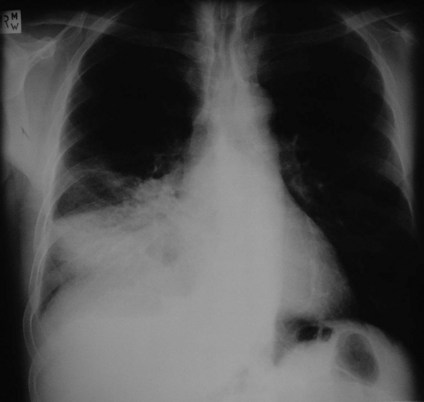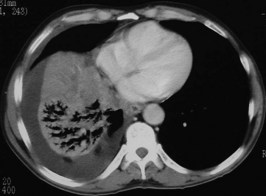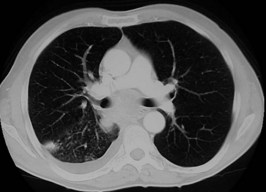Problem 34 Breathlessness and weight loss in a 58-year-old man
A 58-year-old accountant presents with 3 months of progressive breathlessness on exertion. He has no associated chest pain or wheeze but has had a smoker’s cough for years. He has lost 5 kg over the last 3 months but says that his appetite is normal. He complains of a ‘frog in his throat’ for the last 6 weeks, which he has put down to his smoking. His breathlessness has progressed to such an extent that he has been unable to work for the last few days and was only able to walk up the one flight of stairs to your clinic with difficulty. Apart from feeling generally lethargic, he reports no other symptoms.
Q.2
What are the possible diagnoses?
The man looks unwell and dyspnoeic and you decide to admit him to hospital for further management.
A further radiological investigation is performed. Two representative films are shown (Figures 34.2 and 34.3).
Some serum biochemistry had been performed earlier that day. The results are shown in Investigation 34.2.
Answers
• The nature and severity of his shortness of breath. After how much exertion does he get short of breath? How rapidly did this develop? Does it occur at rest, during the night or when he lies flat? How many pillows does he sleep with?
• The nature of his cough. Has it changed? Is it productive and if so is it purulent? Has he coughed up any blood?
• Enquire further about his smoking history. How long has he smoked? Express the smoking history in ‘pack-years’ where 20 cigarettes a day for 1 year is 1 pack-year. Thus a comparative figure can be derived for overall consumption of tobacco measured in terms of the total number of pack-years.
• Are there any other risk factors for lung disease such as industrial exposure to asbestos in the past? Does he keep birds? Has he had any recent foreign travel? Is there a family history of pulmonary disease? Has he had previous cancers or is there a family history of cancers such as colon cancer? Has he had any previous blood clots?
On examination you should look for signs or evidence of the following:
• Malignant lung disease, e.g. clubbing, pleural effusions, lymphadenopathy, hepatomegaly and ascites.
• Cardiac disease, e.g. cardiomegaly, raised jugular venous pressure, atrial fibrillation or peripheral oedema.
In addition you should measure oxygen saturation via pulse oximetry and perform spirometry.
Anaemia may explain his shortness of breath, lethargy and, depending on the cause, his weight loss.
A.3 Perform these investigations:
Stay updated, free articles. Join our Telegram channel

Full access? Get Clinical Tree







